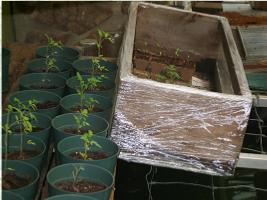Seedling Time
Okay, I know it's the dead of winter most places, but every gardener I know has already thumbed through every seed catalog they could get their hands on, ordered their seeds and went through all the saved seeds from last season.
Now it's time to plant those seeds that you want as plants for your garden. Little things like tomatoes, peppers and summer squashes. The key to successful seedlings is soil. Simply soil.
It doesn't matter if you use little plastic seed trays or jiffy pots, the kind of soil you plant your seeds in will effect the overall health of your plant. If you're going for an organic garden, make sure the potting soil is certified organic if you are purchasing it at a garden center instead of making your own.
We like to use a good quality, nutrient rich potting soil for all of our seedlings. This means no dollar store bargain for us, but rather a name brand soil that has proven itself in the past.
While for some types of plants, I will use those cute little jiffy pots (you know the kind, put in a pan and add water) for the most part, I prefer peat pots. These can go directly from the trays to the ground without disturbing the young plant.
To begin, I fill the peat pots about three fourths full of potting soil and add two or three seeds of the plant of my choice. Then I lightly cover with more soil. Once the tray is full, I lightly water all the pots from the top. After that has soaked in, I'll add water to the bottom of the tray allowing the peat pots to soak the moisture from the bottom.
At this point, the trays are placed in the sunshine of the greenhouse. I'll add water to the trays every couple of days to keep the soil moist, but not overly wet. Within days usually, the seedling will begin to appear.
Generally, I allow them to grow for several weeks. After that, I will thin each pot to one plant; selecting the strongest of each for the garden after last frost.
For some reason, once the seedlings begin to appear, it motivates me to really get to work on the garden. Compost is added, the ground is turned over, the raised beds are readied, all awaiting that wonderful day in May when all the greenhouse vegetables are ready to go in the ground and start their real magic.


